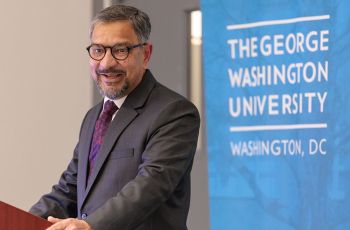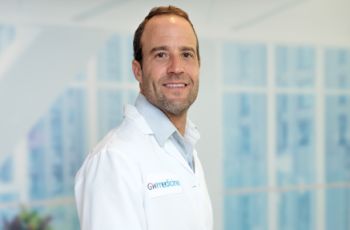
Although he speaks in measured tones, Eduardo M. Sotomayor, M.D., director of the new GW Cancer Center (GWCC), exudes optimism and determination as he describes his vision for the institution: “Driving research innovation, personalized cancer care, and cancer policy from the nation’s capital."
He scrolls through a PowerPoint presentation, recently given to the GW Board of Trustees, and points out his regular caveat, “Not related to SCOTUS Judge Sonia Sotomayor." He laughs before returning to his institutional mission, an inclusive and expansive approach to cancer.
GWCC will act as an umbrella, he explains, encompassing various facets of cancer care, from basic, translational, and clinical research to policy (“It’s my pet project," he confides) and advancements in treatment. He plans to recruit talent from both inside and outside GW, creating a powerful task force for cancer. His more immediate goals include earning a prestigious National Cancer Institute (NCI) designation. The demands are rigorous, but not unfamiliar for a man who frequently transforms the phrase “I think I want to do this" into reality.
From the Beginning
Sotomayor, who readily describes himself as a physician-scientist, started his journey in medicine at age 7, during a trip to the hospital to be treated for an infection; he was fascinated by the health care providers’ compassion. Visits from an uncle, a medical student, cemented his desire to pursue medicine. “At that point, with these two experiences together, I said, ‘I think that I want to be a doctor,’" Sotomayor recalls, a smile spreading across his face at the memory. “My mom said, ‘Are you sure?’ and I said, ‘I want to be a doctor.’"
The ensuing years saw Sotomayor power through secondary and post-secondary school in his native Peru, culminating in graduation from Federico Villarreal Medical School in Lima. He worked for one year in the Peruvian countryside - part of a payback agreement with the government for a tuition-free education - before relocating to Fort Lauderdale, Florida. His initial area of interest was rheumatology.
“I was able to meet Dr. Diana Lopez," Sotomayor says. “She is an immunologist, but she was not working on autoimmune disorders. She was not working in rheumatology. She was working in cancer. I had a meeting with her and said, ‘OK, I think this is what I want to do.’"
For Diana Lopez, Ph.D., professor of microbiology and immunology and director of the undergraduate program at the University of Miami Miller School of Medicine, Sotomayor was a memorable colleague, making his subsequent rise through medicine no surprise to her. “He impressed me so much," she says. “He really is amazing. Hardworking, intelligent, dedicated."
Sotomayor worked with Lopez for three years before he felt the need to return to clinical medicine. “He wanted to do his training as a medical doctor, because that’s what he was," Lopez explains. “He did it here at Jackson Memorial [Hospital], and then he wanted to go and do more research."
Sotomayor landed at Johns Hopkins University in 1995, where he joined a group of oncology researchers working under Hyam Levitsky, M.D. “They were passionate, and they truly believed that one day cancer immunology would be an area that would provide effective cancer treatments," Sotomayor says. “So I said, ‘OK, I think I want to be part of this group.’ "
The researchers were tackling the role of healing T-cells and their ability to destroy cancer cells. Sotomayor narrowed his focus to lymphoma, specifically analyzing the interaction between T-lymphocytes and cancer cells, and the growth of cancerous tumors. Despite skepticism at the time, he was confident in cancer immunotherapy as a revolutionary approach to treatment.
“In 2015, everybody loves cancer immunology," Sotomayor says. “Everybody’s a believer because in the last five years, we’ve had many successes. Everybody wants to be a cancer immunologist now." He adds, jokingly: “I’m kind of a pioneer."
Pioneering Cancer Research and Treatments
As part of his proposed scientific program for GWCC, Sotomayor intends to explore cancer immunology and immunotherapy; his initial plans include expanding ongoing T-cell clinical trials at Children’s National Health System and further developing a cell therapy lab and stem cell transplant program at GW Hospital. He also wants to incorporate the promising fields of cancer epigenetics and microbial oncology, the latter of which pulls in Doug Nixon, Ph.D., Walter G. Ross Professor of Basic Science Research, chair and professor in the Department of Microbiology, Immunology, and Tropical Medicine at the GW School of Medicine and Health Sciences. Nixon is one of the aforementioned internal talents Sotomayor is tapping to head crucial research.
“I believe in internal recruitment," Sotomayor says. “The [researchers, scientists, and engineers] are going to be focusing on areas that a few years from now, we can claim that we are the leaders in."
Finding a Niche
Sotomayor’s resolve to earn the NCI designation is, like his decision to emphasize cancer immunology and research, reflective of his past experience. Four years after joining the team at Johns Hopkins, Sotomayor felt the balmy winds of Florida calling him back.
“I met Eduardo when he was finishing his fellowship at Hopkins and recruited him to Moffitt," explains William S. Dalton, M.D., Ph.D., former president, chief executive officer, and center director of the H. Lee Moffitt Cancer Center and Research Institute at the University of South Florida in Tampa. “It was one of the best hires I’ve ever done."
At Moffitt, Sotomayor served as the scientific director of the center’s DeBartolo Family Personalized Medicine Institute, and at the national level he joined several committees, including the NCI parent committee A, where he helped review NCI-designated centers. The criteria for earning the designation include having established, collaborative research programs and an institutional commitment to, and capability for, cancer care. GW is poised to be the next center on the list.
“We’re going to find our own niche," Sotomayor says. “I think by doing that, we’re going to have a very good chance down the road to get an NCI designation."
The Future: Personalized Medicine
The final component of Sotomayor’s approach is as revolutionary and forward thinking as cancer immunotherapy: personalized medicine.
“Personalized medicine in my view has two essential components," Sotomayor explains, pointing to phenotype and genomic data. “You need both." The key for the components is creating tissue-related and demographics-related databases, where doctors and researchers can determine the makeup of past and current cancer patients; ideally, the information can be used to guide more precise, individualized treatment. “We want to provide state-of-the-art clinical care, we want to do novel clinical trials, and personalized cancer care will be the engine speeding up these efforts," Sotomayor says. “That’s where the field is moving."
The people in his life, those who’ve observed his ascent, believe his success - like the success of GWCC - is guaranteed.
“[GW is] very lucky to have him as the new director," Lopez says.



